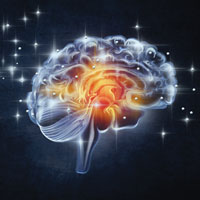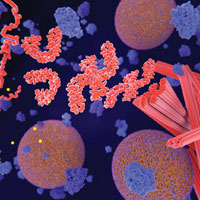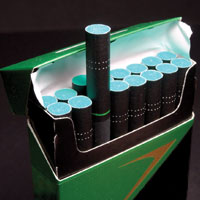Journal Digest: TMS for Psychomotor Symptoms, Effects of Menthol Cigarette Bans, and More
Cognitively Demanding Tasks Associated With Faster Concussion Recovery

The symptoms of adolescents who return to school after a concussion and participate in cognitively demanding activities may resolve faster than those who do not, according to a study in the British Journal of Sports Medicine. However, improved symptom resolution was not seen if the activities involved significant screen time.
Researchers at Children’s Hospital in Columbus, Ohio, and colleagues followed 83 adolescents aged 11 to 17 who had a concussion within 72 hours for up to 45 days. The participants recorded the intensity and duration of the cognitive activities they performed each day as well as any post-concussive symptoms. Cognitive intensity was grouped into three categories: low (for example, listening to music), medium (for example, being in class), or high (for example, taking a test). On average, the participants performed 191, 166, and 38 minutes of low- , moderate- , and high-intensity cognitive activities, respectively, each day.
Overall, the researchers found that every 10 minutes per hour spent doing a moderate- or high-intensity cognitive activity was associated with 22% faster symptom recovery. In contrast, every day postinjury that the adolescent did not go to school was associated with 8% slower symptom recovery.
Not all activities were positively associated with improvement. For example, the researchers found that every 10 minutes per hour spent video gaming (considered a moderate-intensity activity) during the first week of concussion recovery was associated with 29% slower symptom recovery.
“These findings suggest that low-intensity cognitive activities such as listening to music, watching TV, and texting may be permitted in the days following concussion, but gaming and surfing the internet for more than a few minutes should be discouraged,” the researchers wrote.
Yang J, Alshaikh E, Asa N, et al. Exploring the Association Between Cognitive Activity and Symptom Resolution Following Concussion in Adolescents Aged 11-17 Years. Br J Sports Med. 2024; 58(6): 328-333.
Low-Frequency TMS Improves Psychomotor Schizophrenia Symptoms

Low-frequency transcranial magnetic stimulation (TMS) can improve symptoms of psychomotor slowing in individuals with schizophrenia, according to a clinical trial from investigators at the University of Bern, Switzerland. Psychomotor slowing involves impairment to both fine and gross motor movements, making tasks like walking or talking difficult.
“Psychomotor slowing often comes with multiple disadvantages, such as cognitive impairment, sedentary behavior, cardiometabolic risks, poor quality of life, lower subjective well-being, and impaired functioning,” the investigators wrote in JAMA Psychiatry.
This trial involved 88 adults (aged 18 to 60) with schizophrenia spectrum disorder and severe psychomotor slowing, defined as a score of 15 or more on the Salpêtrière Retardation Rating Scale (SRRS). The participants were evenly divided to receive repetitive TMS (rTMS) at 1-hertz, intermittent theta burst stimulation (iTBS) at 50-hertz, or sham stimulation or be placed on a waiting list. All stimulation protocols involved 15 sessions across three weeks targeting the supplementary motor area; after three weeks, the wait list group all received the low-frequency rTMS. Participants were allowed to continue taking their existing medications.
After three weeks, 68% of adults who received rTMS responded to treatment, defined as at least a 30% improvement in SRRS scores. By comparison, 36% of iTBS recipients, 32% of sham participants, and 18% of adults on the waitlist responded to treatment. After adjusting for demographic variables and medication use, the researchers estimated someone receiving rTMS had more than 80% greater odds of responding than someone receiving iTBS or sham.
Further, 63% of the waitlist group responded to rTMS once they got the treatment. The investigator reported that no participants experienced severe adverse events, and the most common side effects were fatigue and head/neck pain.
Walther S, Alexaki D, Weiss F, et al. Psychomotor Slowing in Psychosis and Inhibitory Repetitive Transcranial Magnetic Stimulation: A Randomized Clinical Trial. JAMA Psychiatry. February 28, 2024. Online ahead of print.
Receptor Identified That Brings Toxic Tau Fragments Into Neurons

While much Alzheimer’s research focuses on the amyloid protein, another protein called tau has also been implicated in this disorder. In laboratory research published in Advanced Science, a team at Johns Hopkins University and colleagues identified the receptor that may be responsible for carrying toxic tau fragments into cells. This receptor, called LAG-3, is already the target of a recently approved melanoma antibody therapy (relatlimab), suggesting it may be a valid therapeutic target for Alzheimer’s.
While the tau protein can attach to numerous receptors on the surface of neurons to get inside, the researchers observed that LAG-3 was special in that it specifically binds to fibrillar tau—a misfolded and sticky version of the protein that induces other tau proteins to misfold and clump together, forming toxic aggregates.
The researchers generated a mouse model that lacked LAG-3 receptors in the brain and then injected them with fibrillar tau; compared with regular mice, the LAG-3-deficient mice accumulated far less toxic tau in their neurons. The mice deficient in LAG-3 that were injected with tau also showed fewer behavioral deficits, such as increased anxiety or reduced sociability than regular mice. The researchers could replicate the protective effects of LAG-3 deletion by giving regular mice an LAG-3 antibody that blocks the entrance to the receptor.
“Emerging studies have shown the expression of [LAG-3] receptors is on neurons, microglia, and astroglia, where they exert diverse functions,” the researchers wrote. “It would be valuable to determine the roles of these tau receptors in different cell types.”
Chen C, Kumbhar R, Wang H, et al. Lymphocyte-Activation Gene 3 Facilitates Pathological Tau Neuron-to-Neuron Transmission. Adv Sci (Weinh). February 7, 2024. Online ahead of print.
Peer-Led Workshop for Postpartum Depression Found Effective

A one-day, online workshop about postpartum depression, delivered by mothers who experienced postpartum depression, is both an effective and cost-effective therapeutic strategy, according to a study in Psychotherapy and Psychosomatics.
The efficacy of a workshop, which condenses key principles of cognitive-behavioral therapy (CBT) into a one-day session, has been demonstrated previously, but earlier sessions were delivered by professionals. The investigators from McMaster University in Hamilton, Ontario, and colleagues noted that many individuals with postpartum depression “express a preference for treatments delivered by someone who they feel truly understands their experiences.”
They enrolled 405 mothers of infants up to 12 months old to take part in the workshop or continue with their usual care and take part in the workshop after 12 weeks (waitlist). All participants had Edinburgh Postnatal Depression Scale (EPDS) scores of 10 or higher. The workshop included six hours of instruction along with breaks, delivered by a pair of peer facilitators who had undergone brief CBT training from a perinatal psychiatrist.
After 12 weeks, the mothers who took the CBT workshop decreased their EPDS scores by 4.58 points, compared with a 2.97-point deduction in the waitlist group; this difference was statistically significant. The mothers in the workshop group also reported greater improvements in general anxiety, infant-focused anxiety, parenting stress, and infant temperament compared with the waitlist group.
Further, workshop participants accrued almost $100 less (Canadian) in health care costs per person over 12 weeks ($968 versus $1,063 in the waitlist group), primarily due to fewer emergency department visits. Given that each workshop can accommodate up to 30 participants and the peer facilitators cost only $30/hour each, the investigators calculated a high likelihood that this protocol is cost-effective.
Babiy Z, Layton H, Savoy CD, et al. One-Day Peer-Delivered Cognitive Behavioral Therapy–Based Workshops for Postpartum Depression: A Randomized Controlled Trial. Psychother Psychosom. January 25, 2024. Online ahead of print.
Menthol Cigarette Bans May Lead Some People to Quit Smoking

A systematic review and meta-analysis published in Nicotine and Tobacco Research suggests that menthol cigarette bans can encourage some smokers to quit, though a large majority may switch to nonflavored cigarettes or other products like e-cigarettes.
Researchers at the University of North Carolina and colleagues reviewed 20 studies that explored real-world outcomes of places that enacted a menthol ban, as well as 32 studies that surveyed smokers about their response to a hypothetical ban.
The real-world data indicated that smoking cessation rates among menthol smokers were higher following a menthol ban compared with other smokers. National menthol bans (such as implemented in Canada or the European Union) appear more effective than bans at the state and local levels because smokers were still able to keep smoking menthol cigarettes obtained in neighboring areas.
To obtain more quantitative data, the researchers next conducted a meta-analysis of three studies that assessed smoking behaviors one to two years following national bans in Ontario, across Canada, and in the Netherlands. The results indicated that about 24% of menthol smokers quit smoking, while 50% switched to another tobacco product and 24% continued smoking menthols.
“This review provides a snapshot of what is known about the impacts of menthol bans,” the researchers concluded. “This literature is an evolving area as more localities and countries implement menthol bans, the tobacco industry responds to the changing regulatory environment with new products, and the longer-term impacts of menthol bans emerge.” ■
Mills SD, Peddireddy S, Kurtzman R, et al. The Impact of Menthol Cigarette Bans: A Systematic Review and Meta-Analysis. Nicotine Tob Res. February 21, 2024. Online ahead of print.



